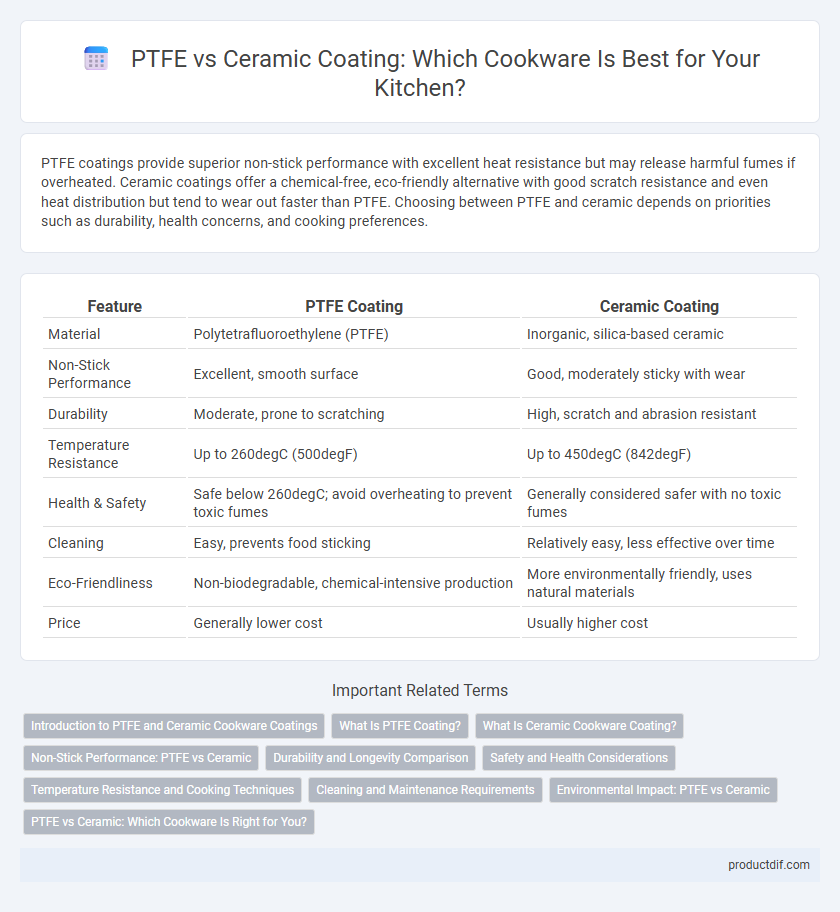PTFE coatings provide superior non-stick performance with excellent heat resistance but may release harmful fumes if overheated. Ceramic coatings offer a chemical-free, eco-friendly alternative with good scratch resistance and even heat distribution but tend to wear out faster than PTFE. Choosing between PTFE and ceramic depends on priorities such as durability, health concerns, and cooking preferences.
Table of Comparison
| Feature | PTFE Coating | Ceramic Coating |
|---|---|---|
| Material | Polytetrafluoroethylene (PTFE) | Inorganic, silica-based ceramic |
| Non-Stick Performance | Excellent, smooth surface | Good, moderately sticky with wear |
| Durability | Moderate, prone to scratching | High, scratch and abrasion resistant |
| Temperature Resistance | Up to 260degC (500degF) | Up to 450degC (842degF) |
| Health & Safety | Safe below 260degC; avoid overheating to prevent toxic fumes | Generally considered safer with no toxic fumes |
| Cleaning | Easy, prevents food sticking | Relatively easy, less effective over time |
| Eco-Friendliness | Non-biodegradable, chemical-intensive production | More environmentally friendly, uses natural materials |
| Price | Generally lower cost | Usually higher cost |
Introduction to PTFE and Ceramic Cookware Coatings
PTFE (polytetrafluoroethylene) cookware coatings, known for their non-stick properties, provide smooth surfaces that resist food adhesion and ease cleaning. Ceramic coatings, derived from inorganic minerals, offer a non-toxic, high-heat resistant alternative without synthetic chemicals. Both types enhance cooking efficiency by reducing the need for excessive oils while catering to different durability and safety preferences.
What Is PTFE Coating?
PTFE coating, commonly known as Teflon, is a synthetic polymer used in cookware to provide a nonstick surface that reduces the need for oil and facilitates easy food release. This coating offers excellent heat resistance and chemical stability, making it a popular choice for everyday cooking. PTFE's smooth, slippery surface minimizes food sticking while being durable enough to withstand extensive use under moderate temperatures.
What Is Ceramic Cookware Coating?
Ceramic cookware coating is a non-stick surface made from inorganic minerals derived from sand, offering a chemical-free alternative to PTFE-based coatings. It provides excellent heat resistance, durability, and a smooth, non-toxic cooking experience without releasing harmful fumes at high temperatures. This coating is favored for its eco-friendly properties and easy cleanup, making it a popular choice for health-conscious cooking enthusiasts.
Non-Stick Performance: PTFE vs Ceramic
PTFE coatings offer superior non-stick properties, providing easy food release and minimal oil usage, which enhances cooking convenience. Ceramic coatings, while non-stick, generally have a slightly firmer surface that may require more oil and careful maintenance to prevent food from sticking. Over time, PTFE maintains its slickness better, whereas ceramic coatings can wear down faster, impacting long-term non-stick performance.
Durability and Longevity Comparison
PTFE coatings offer excellent non-stick properties but tend to degrade faster under high heat, typically lasting 3 to 5 years with proper care. Ceramic coatings provide superior heat resistance and maintain their non-stick quality longer, often extending cookware longevity to 7 years or more. Both coatings require gentle cleaning to maximize durability, but ceramic surfaces are generally more scratch-resistant and less prone to peeling over time.
Safety and Health Considerations
PTFE cookware is valued for its nonstick properties but may release harmful fumes if overheated above 500degF, posing respiratory risks. Ceramic coatings offer a safer alternative, as they are free from PTFE and PFOA, reducing the potential for toxic emissions and heavy metal exposure during cooking. Both types require careful temperature management to maintain durability and ensure safe food preparation.
Temperature Resistance and Cooking Techniques
PTFE coatings offer excellent non-stick properties but typically withstand temperatures up to 260degC (500degF) before degrading, making them ideal for low to medium-heat cooking such as sauteing and frying. Ceramic coatings tolerate higher temperatures, often up to 450degC (842degF), supporting techniques like searing and browning without releasing harmful fumes. Choosing between PTFE and ceramic depends on desired heat resistance and specific cooking methods used.
Cleaning and Maintenance Requirements
PTFE-coated cookware offers nonstick properties that simplify cleaning, often requiring just warm soapy water and a soft sponge to remove food residues. Ceramic-coated cookware, while also nonstick, demands gentle cleaning to avoid abrasive materials that can damage the coating and reduce its lifespan. Both coatings benefit from hand washing and avoiding metal utensils to maintain their performance and durability over time.
Environmental Impact: PTFE vs Ceramic
PTFE cookware involves synthetic polymers derived from non-renewable petroleum resources, contributing to environmental concerns during production and disposal due to persistent chemical residues and potential release of toxic fumes when overheated. Ceramic coatings, made from natural minerals like silica, offer a more eco-friendly alternative with non-toxic, biodegradable properties and lower environmental footprint throughout their manufacturing and end-of-life stages. Choosing ceramic coating reduces hazardous waste and supports sustainable kitchen practices by minimizing chemical pollution and enhancing recyclability.
PTFE vs Ceramic: Which Cookware Is Right for You?
PTFE cookware offers superior non-stick performance and easy food release, ideal for low to medium heat cooking, while ceramic-coated cookware provides a chemical-free, environmentally friendly option with higher heat tolerance. PTFE coatings may degrade at high temperatures and release fumes, whereas ceramic coatings resist scratching and support healthier cooking with minimal oil. Choosing between PTFE and ceramic depends on your cooking style, heat preferences, and priorities regarding durability and health considerations.
PTFE vs Ceramic Coating Infographic

 productdif.com
productdif.com